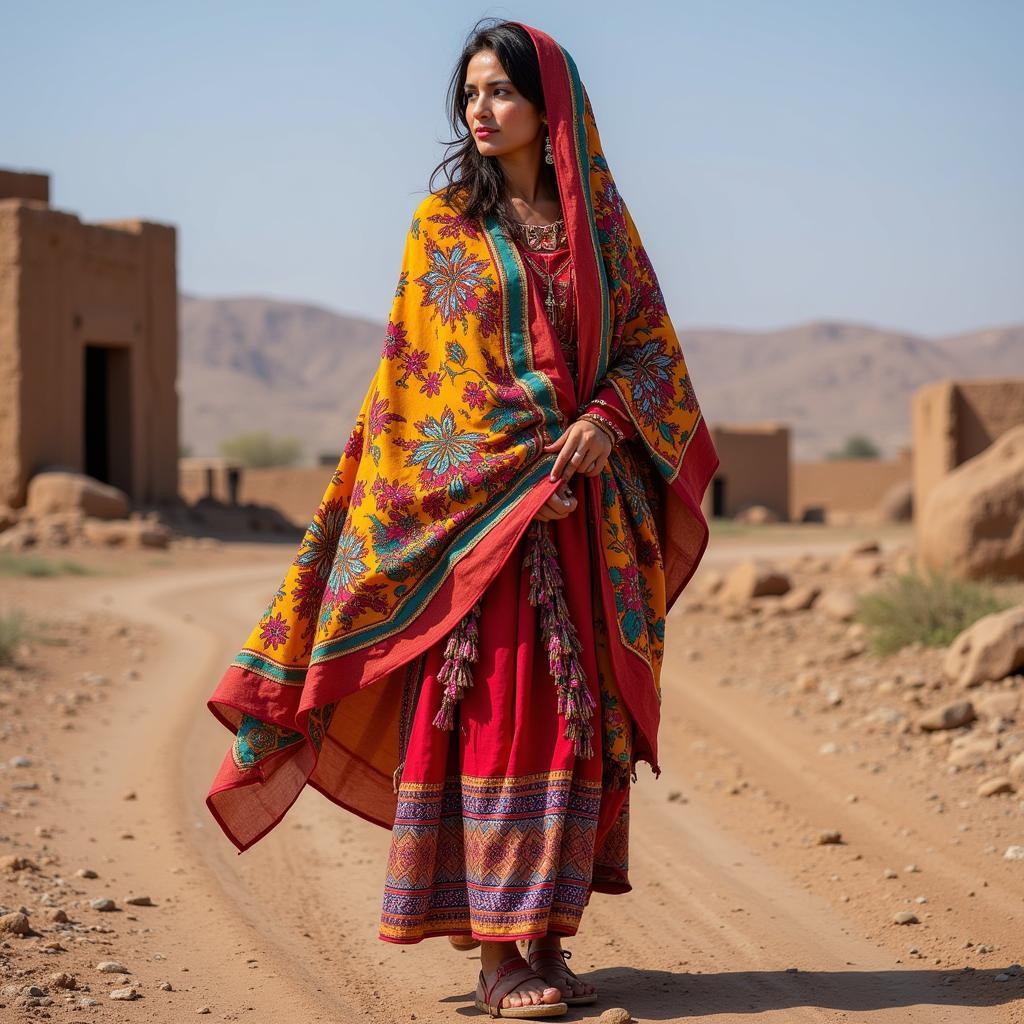The dupatta, an integral part of Pakistani attire, transcends mere clothing to become a symbol of cultural identity, grace, and tradition. From the vibrant hues of Punjab to the intricate embroideries of Sindh, dupas in Pakistan are as diverse as the country itself. This guide delves into the fascinating world of dupas, exploring their history, styles, and significance in Pakistani society.
The History and Evolution of Dupas in Pakistan
The history of dupas in Pakistan is intertwined with the region’s rich textile heritage. Evidence suggests that shawl-like garments, precursors to the modern dupatta, were worn as early as the Indus Valley Civilization. Over the centuries, influences from Persian, Mughal, and Central Asian cultures shaped the evolution of the dupatta, resulting in the variety of styles we see today.
A Tapestry of Styles: Exploring Regional Dupatta Variations
Pakistan’s diverse cultural landscape is reflected in the wide array of dupatta styles found across its provinces. Each region boasts unique fabrics, embroidery techniques, and draping styles that speak to its distinct heritage.
Punjab: The Vibrant Heart of Dupatta Tradition
Punjab, known for its vibrant culture, is home to some of the most striking dupatta styles. Phulkari, meaning “flower work,” is a renowned embroidery technique where silk threads are used to create intricate floral patterns on brightly colored cotton dupattas. These dupattas are often passed down through generations as cherished heirlooms.
Sindh: Where Embroidery Meets Elegance
Sindhi dupattas are characterized by their delicate embroidery and intricate mirror work. Utilizing techniques like rilli, which involves tiny stitches that create intricate patterns, and gota patti, where gold or silver ribbon is appliquéd onto the fabric, Sindhi artisans create dupattas that are both elegant and eye-catching.
Balochistan: A Fusion of Cultures
The dupattas of Balochistan reflect the region’s unique blend of Pakistani, Persian, and Afghan influences. These dupattas are often made from lightweight fabrics like silk or chiffon and feature intricate embroidery, mirror work, and beading.
 Baloch Woman in Traditional Attire with a Dupatta
Baloch Woman in Traditional Attire with a Dupatta
Khyber Pakhtunkhwa: Bold Colors and Geometric Patterns
The dupattas of Khyber Pakhtunkhwa are known for their bold colors and geometric patterns. Woven from locally sourced wool or silk, these dupattas often feature intricate embroidery using techniques like cross-stitch and chain stitch. The use of mirrors and beads adds a touch of sparkle to these vibrant textiles.
Beyond Fashion: The Cultural Significance of Dupas in Pakistan
In Pakistani society, dupattas are much more than just fashion accessories. They hold deep cultural and social significance, representing modesty, respect, and tradition.
“The dupatta is an extension of a woman’s grace and elegance,” says Ayesha Khan, a renowned Pakistani fashion designer. “It adds a touch of sophistication and completes any outfit.”
Dupattas are often gifted on special occasions like weddings and Eid, symbolizing blessings and good wishes. They are also worn as a mark of respect when visiting religious places or attending formal gatherings.
Conclusion: Celebrating the Timeless Appeal of Dupas
Dupas in Pakistan are a testament to the country’s rich textile heritage and cultural diversity. From the intricate embroideries of Sindh to the vibrant hues of Punjab, each dupatta tells a story of tradition, craftsmanship, and timeless elegance. As Pakistan continues to evolve, one thing remains constant: the enduring appeal of the dupatta as a symbol of cultural identity and grace.
FAQs:
- What is the best fabric for a dupatta?
- The choice of fabric depends on personal preference and occasion. Popular choices include silk, chiffon, cotton, and georgette.
- How do I style a dupatta?
- There are countless ways to drape a dupatta. Experiment with different styles to find what suits you best.
- Are dupattas only worn by women?
- While traditionally worn by women, men in some regions of Pakistan also wear dupattas as part of their cultural attire.
- Where can I buy authentic Pakistani dupattas?
- You can find beautiful Pakistani dupattas at local boutiques, handicraft shops, and online retailers specializing in Pakistani clothing.
- How do I care for my dupatta?
- Always follow the care instructions on the label. Delicate fabrics like silk and chiffon may require dry cleaning.
For any assistance regarding Pakistani culture, news, or travel, please contact us at +923337849799, [email protected], or visit our office at Dera Ghazi Khan Rd, Rakhni, Barkhan, Balochistan, Pakistan. Our customer service team is available 24/7 to assist you.
Leave a Reply